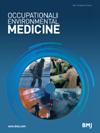疫苗接种率对 SARS-CoV-2 职业风险差异的潜在影响:国家统计局 COVID-19 感染调查分析
IF 3.9
2区 医学
Q1 PUBLIC, ENVIRONMENTAL & OCCUPATIONAL HEALTH
引用次数: 0
摘要
目的 评估不同职业群体疫苗接种率的差异,并以此作为 SARS-CoV-2 感染风险差异的潜在解释。设计 我们分析了英国国家统计局 COVID-19 感染调查的数据以及英格兰国家免疫管理系统 2020 年 12 月 1 日至 2022 年 5 月 11 日的疫苗接种数据。我们按职业类别分析了疫苗接种率和 SARS-CoV-2 感染风险,并评估了疫苗接种调整是否减少了职业类别之间的风险差异。结果 所有职业类别的三联疫苗估计接种率都很高(80%或以上),但食品加工(80%)、个人护理(82%)、酒店服务(83%)、体力劳动(84%)和零售(85%)的接种率最低。在卫生领域工作的人员(95%为办公室工作人员,92%为面向患者的工作人员)、教育工作者(91%)以及未纳入其他类别的办公室工作人员(90%)的接种率较高。在估算感染相对风险时对疫苗接种情况进行调整的影响一般不大(所有职业组的危险比从 1.37 降至 1.32),但与疫苗接种率低导致某些组别风险升高的假设一致。结论 疫苗接种覆盖率的差异可能是造成感染风险职业差异的一小部分原因。在这组人群中,疫苗接种率都非常高,这可能表明参与者并不代表普通人群。因此,在积累更多证据之前,这些结果应被视为暂时性的。数据可能来自第三方,不对外公布。国家统计局(ONS)的冠状病毒感染调查数据只有获得国家统计局认证的研究人员才能访问。研究人员可通过研究认证服务申请认证。访问通过安全研究服务进行,并以项目为基础进行审批。更多详情,请参阅.本文章由计算机程序翻译,如有差异,请以英文原文为准。
Potential contribution of vaccination uptake to occupational differences in risk of SARS-CoV-2: analysis of the ONS COVID-19 Infection Survey
Objectives To assess variation in vaccination uptake across occupational groups as a potential explanation for variation in risk of SARS-CoV-2 infection. Design We analysed data from the UK Office of National Statistics COVID-19 Infection Survey linked to vaccination data from the National Immunisation Management System in England from 1 December 2020 to 11 May 2022. We analysed vaccination uptake and SARS-CoV-2 infection risk by occupational group and assessed whether adjustment for vaccination reduced the variation in risk between occupational groups. Results Estimated rates of triple vaccination were high across all occupational groups (80% or above), but were lowest for food processing (80%), personal care (82%), hospitality (83%), manual occupations (84%) and retail (85%). High rates were observed for individuals working in health (95% for office based, 92% for those in patient-facing roles) and education (91%) and office-based workers not included in other categories (90%). The impact of adjusting for vaccination when estimating relative risks of infection was generally modest (ratio of hazard ratios across all occupational groups reduced from 1.37 to 1.32), but was consistent with the hypothesis that low vaccination rates contribute to elevated risk in some groups. Conclusions Variation in vaccination coverage might account for a modest proportion of occupational differences in infection risk. Vaccination rates were uniformly very high in this cohort, which may suggest that the participants are not representative of the general population. Accordingly, these results should be considered tentative pending the accumulation of additional evidence. Data may be obtained from a third party and are not publically available. Office of National Statistics (ONS) Coronavirus Infection Survey data can be accessed only by researchers who are ONS accredited researchers. Researchers can apply for accreditation through the Research Accreditation Service. Access is through the Secure Research Service and approved on a project basis. For further details, see: .
求助全文
通过发布文献求助,成功后即可免费获取论文全文。
去求助
来源期刊

Occupational and Environmental Medicine
医学-公共卫生、环境卫生与职业卫生
CiteScore
8.30
自引率
2.00%
发文量
98
审稿时长
2 months
期刊介绍:
Occupational and Environmental Medicine is an international peer reviewed journal covering current developments in occupational and environmental health worldwide. Occupational and Environmental Medicine publishes high-quality research relating to the full range of chemical, physical, ergonomic, biological and psychosocial hazards in the workplace and to environmental contaminants and their health effects. The journal welcomes research aimed at improving the evidence-based practice of occupational and environmental research; including the development and application of novel biological and statistical techniques in addition to evaluation of interventions in controlling occupational and environmental risks.
 求助内容:
求助内容: 应助结果提醒方式:
应助结果提醒方式:


